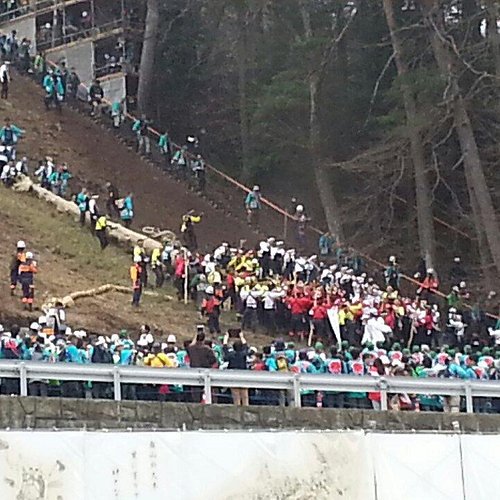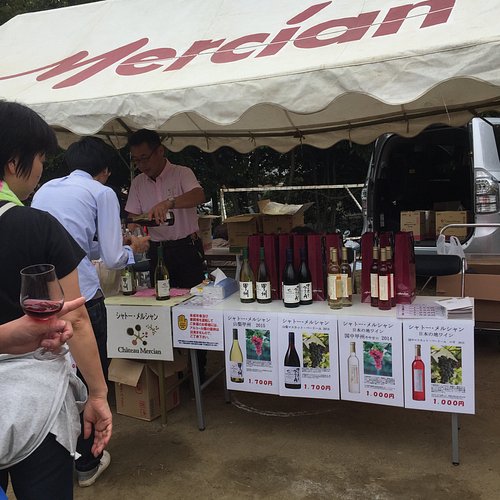What to do and see in Koshinetsu, Chubu: The Best Cultural Events
Discover the best top things to do in Koshinetsu, Japan including Onbashira, Tokamachi Snow Festival, Koshu City Katsunuma Grape Festival, Lake Yamanaka Art Illmination Fantasium, Fuji Lake Kawaguchi Koyo Festival, Murakami Taisai, Echigo Urasa Bishamon Hadaka Oshiai Taisai, Nigata Matsuri, Lake Kawaguchi Herb Festival, Yoshida Himatsuri.
Restaurants in Koshinetsu
1. Onbashira
Overall Ratings
4.5 based on 31 reviews
The Onbashira festival is held only once every six years, to metaphorically revitalize the Suwa shrines. The historic and lengthy event has been performed for over 1,200 years in Japan, and consists of two month-long components. The Yamadashi takes place in April, during which four very large tree trunks are felled by hand axes in the cemetery of a shinto shrine. They are wrapped and adorned in red and white, and then dragged by teams of men towards the Shinto shrines, who test their courage during the trial by performing "kiotoshi": dangerously riding the logs downhill on rough inclines. The Satokibi, in May, sees these logs used as symbolic support structures. They are raised in the shrines by hand, while one man straddles the top, singing. When it is fully raised, and the man on top balanced many feet in the air, success is declared. A remarkable spectacle.
2. Tokamachi Snow Festival
Overall Ratings
4.5 based on 26 reviews
A winter festival of Tokamachi, Niigata Prefecture, which is known as one of Japan's leading heavy snowfall areas. It began in 1950 with the local residents' concept of "enjoy the snow, as a friend of the snow." The main event is the residents' handmade "artworks made of snow." The collection of huge artistic works makes a big impression on the viewer. In addition, "festival plazas" in almost 30 locations in the city and surrounding villages, you can enjoy such things as regional cuisine, snow tea ceremony, and snow slides. And the "Snow Carnival," live music and shows held on a huge stage made of snow, is not to be missed.
3. Koshu City Katsunuma Grape Festival
Overall Ratings
4.5 based on 13 reviews
The grape festival is held in Katsunuma, Koshu City, a place renowned for its grapes and wine. The festival takes place in Katsunuma Central Park, where you can enjoy free grapes and wine, and where there is a corner where you can buy a wineglass in order to sample the wine at booths run by wineries in the city. The festival includes stages for drumming and music as well as events such as a procession with a majestic portable shrine. In the evening, the night sky is lit up by the haunting scene of a burning torii gate as well as by beautiful fireworks overhead.
4. Lake Yamanaka Art Illmination Fantasium
Overall Ratings
4.5 based on 8 reviews
"Fantasium" is a term coined from the words "fantasy" and "museum," and this event features an outdoor museum of art illumination that is set up for a limited time on the shore of Lake Yamanaka. Located in Hana-no-miyako Park, the museum exhibits a variety of works, and the glitter of the lighting art against the background of Mt. Fuji lends to the entire site a fantastical feeling. Fireworks are set off on occasions such as Christmas and New Year's, and a Christmas concert is also held here.
5. Fuji Lake Kawaguchi Koyo Festival
Overall Ratings
4.5 based on 45 reviews
The Fuji Lake Kawaguchi Koyo Festival is held in autumn right when the foliage on Lake Kawaguchi turns a beautiful color. A range of stalls plying wares also appear around the venue. The must-see of the event is the "foliage tunnel," where sixty massive trees around the Nashigawa are illuminated at night. From dusk until 10:00 PM, this romantic light-up enchants visitors.
Reviewed By alittlebitofskye - Sydney, Australia
My partner & I spend a couple of hours here in the evening. The trees were beautifully lit, although the corridor hadn’t hit full peak just yet. There was lots of food vendors and market stalls. Lots of parking options if you are driving and temporary bathroom facilities are there to cater for large crowds. The night we visited wasn’t too crowded. Lots of event staff who were able to help even if their English was limited. The event had a great vibe and was thoroughly enjoyable. TIP: if you aren’t driving, please take note of when the last bus to Kawaguchiko is, which was at about 7:30 the night we visited. Otherwise you will need get a taxi back.
6. Murakami Taisai
Overall Ratings
4.0 based on 3 reviews
Murakami Taisai is held yearly from July 6-7 at Senamihaguro Shrine in Haguro in the city of Murakami. It is a traditional festival that has been celebrated since 1633 and is designated as an Intangible Folk Cultural Property of Niigata Prefecture. The highlight of the festival are the 19 festival cars called oshagiri. They are over 5 meters tall and split into two levels: the first level houses the hayashi (Japanese orchestra), while the second level is full of decorations called nosemono. The dazzling floats house some items that are over 200 years old, and are paraded around the town for all to enjoy their engravings, laquering and goldsmithing.
7. Echigo Urasa Bishamon Hadaka Oshiai Taisai
Overall Ratings
4.0 based on 6 reviews
One of Japan's "Three Weird Festivals," the Echigo Urasa Bishamon Hadaka Oshiai Taisai is desigated as a national Selected Intangible Folk Cultural Property, with a history of around 1,200 years. This full-impact festival is alive with the spirit and enthusiasm of a throng of half-naked men jostling before an elevated shrine to Bishamonten, yelling, "Sanyo! Sanyo!" As they try to pray faster and closer than the others. Participation in the jostling contest is open to all who are interested (males only).
8. Nigata Matsuri
Overall Ratings
4.0 based on 19 reviews
The Nigata Matsuri is a combination of four existing festivals: the Sumiyoshi Festival, the Commerce Festival, the Boating Festival, and the Port Commemorative Festival. The festival opens with over 10,000 people dancing to folk songs and chrysanthemum fireworks illuminating the darkness. The next day, festivities continue with the mikoshi (portable shrine) and taiko drums in the Sumiyoshi Parade, a procession of participants in traditional garb around 1 kilometer in length. Another highlight is the Niigata Sparkly Parade, with drum-and-fife bands, baton troupes, and Niigata Oldtown geisha riding floats. There is also the "aquatic mikoshi procession" that takes place when the mikoshi is carried over Shinano River, and from dusk citizens march with the mikoshi. The festivities come to a climax at night with a fireworks display set to music, lighting up the night sky. On the final day, a fireworks display caps off the festival with large-size wide chrysanthemum fireworks and waterfall fireworks.
9. Lake Kawaguchi Herb Festival
Overall Ratings
4.0 based on 19 reviews
This event is held primarily in Yagizaki Park and Oishi Park on the shore of Lake Kawaguchi. From early June through mid-July, the lavender plants are in full bloom, creating a beautiful scene that looks as though the land is covered with a purple carpet. Particularly photogenic is the contrast between Mt. Fuji, Lake Kawaguchi, and the lavender blossoms as seen from Oishi Park. At Oishi Park, the primary venue for the festival, you can buy herb seedlings and herbal products and also enjoy light meals made using herbs.
10. Yoshida Himatsuri
Overall Ratings
4.0 based on 12 reviews
The Yoshida Fire Festival is one of the Three Bizarre Festivals of Japan. The festival is held every year for two days - August 26th and 27th - as a festival to mark the end of the summer climbing season on Mt. Fuji. The event starts with a Shinto ritual and a portable shrine, then in the evening of August 26th a row of three-meter-high torches that have been set up along the main street in Fuji Yoshida are lit. At the same time, torches are lit one after another at the mountain lodges on Mt. Fuji, and the excitement reaches its peak when all of this turns into a single pathway of light. Nearby are open-air stands, making for a bustling atmosphere. The festival has also been designated an Important Intangible Folk-Culture Asset of Yamanashi Prefecture.








